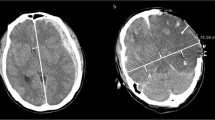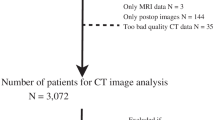Abstract
Background
Marshall computed tomographic (CT) classification is widely used as a predictor of outcome. However, this grading system lacks the following variables, which are found to be useful predictors: subarachnoid/intraventricular hemorrhage, extradural hematoma, and extent of basal cistern compression. A new classification called the Rotterdam grading system, incorporating the above variables, was proposed later. In the original paper, this system was found to have superior discrimination as compared to Marshall grading, however, Rotterdam grading has not been validated widely. We aimed to compare the discriminatory power of both grading systems.
Methods
This is a prospective study of patients with moderate and severe TBI (Glasgow coma scale (GCS) 3–12) who presented to our casualty. All the patients were followed up for 2 weeks to determine early mortality. The discriminatory power of each grading system was determined using area under the receiver operating characteristic curve (AUC).
Results
A total of 134 patients, mean age 38.3 (±15.7) years, were recruited for study. The overall mortality was 11.2 %. The mean GCS of these patients was 9.6 (±2.3). There was good correlation between Marshall and Rotterdam grading, r = 0.68 (significant at 0.01 level). The Marshall CT classification had reasonable discrimination (AUC - 0.707), and Rotterdam grading had good discrimination (AUC - 0.681).
Conclusions
Both Marshal and Rotterdam grading systems are good in predicting early mortality after moderate and severe TBI. As the Rotterdam system also includes additional variables like subarachnoid hemorrhage, it may be preferable, particularly in patients with diffuse injury.



Similar content being viewed by others
References
Bobinski L, Olivecrona M, Koskinen L-OD (2012) Dynamics of brain tissue changes induced by traumatic brain injury assessed with the Marshall, Morris-Marshall, and the Rotterdam classifications and its impact on outcome in a prostacyclin placebo-controlled study. Acta Neurochir (Wien) 154(6):1069–1079
Brain Trauma Foundation (2000) Early indicators of prognosis in severe traumatic brain injury. J Neurotrauma 17(6–7):555–627
Bullock MR, Chesnut R, Ghajar J, Gordon D, Hartl R, Newell DW, Servadei F, Walters BC, Wilberger JE (2006) Guidelines for the surgical management of traumatic brain injury. Neurosurgery 58(Supplement):S2–S62
Maas AIR, Hukkelhoven C, Marshall LF, Steyerberg EW (2005) Prediction of outcome in traumatic brain injury with computed tomographic characteristics: a comparison between the computed tomographic classification and combinations of computed tomographic predictors. Neurosurgery 57(6):1173–1182
Marshall LF, Marshall SB, Klauber MR, Clark MV (1991) A new classification of head injury based on computerized tomography. J Neurosurg 75(1s):S14–S20
Mata-Mbemba D, Mugikura S, Nakagawa A, Murata T, Ishii K, Li L, Takase K, Kushimoto S, Takahashi S (2014) Early CT findings to predict early death in patients with traumatic brain injury: Marshall and Rotterdam CT scoring systems compared in the major academic tertiary care hospital in northeastern Japan. Acad Radiol 21(5):605–611
Morris GF, Marshall LF (1977) A new, practical classification of traumatic subarachnoid hemorrhage. Acta Neurochir 71:382
Nelson DW, Maccallum RM, Lilja A (2010) Extended analysis of early computed tomography scans of traumatic brain injured patients. J Neurotrauma 64:51–64
Perel P, Arango M, Clayton T, Edwards P, Komolafe E, Poccock S, Roberts I, Shakur H, Steyerberg E, Yutthakasemsunt S (2008) Predicting outcome after traumatic brain injury: practical prognostic models based on large cohort of international patients. BMJ 336(7641):425–429
Raj R, Siironen J, Skrifvars MB, Hernesniemi J, Kivisaari R (2014) Predicting outcome in traumatic brain injury. Neurosurgery 75(6):632–647
Saatman KE, Duhaime A-C, Bullock R, Maas AIR, Valadka A, Manley GT (2008) Classification of traumatic brain injury for targeted therapies. J Neurotrauma 25(7):719–738
Servadei F, Murray GD, Teasdale GM et al (2002) Traumatic subarachnoid hemorrhage: demographic and clinical study of 750 patients from the European brain injury consortium survey of head injuries. Neurosurgery 50(2):261–267, discussion 267–9
Shukla D, Devi BI (2010) Mild traumatic brain injuries in adults. J Neurosci Rural Pract 1(2):82–88
Shukla D, Devi I, Agrawal A (2011) Outcome measures for traumatic brain injury. Clin Neurol Neurosurg 113(6):435–441
Shukla D, Mahadevan A, Sastry KVR, Shankar SK (2007) Pathology of post traumatic brainstem and hypothalamic injuries. Clin Neuropathol 26(5):197–209
Conflict of interest
All authors certify that they have NO affiliations with or involvement in any organization or entity with any financial interest (such as honoraria; educational grants; participation in speakers’ bureaus; membership, employment, consultancies, stock ownership, or other equity interest; and expert testimony or patent-licensing arrangements), or non-financial interest (such as personal or professional relationships, affiliations, knowledge or beliefs) in the subject matter or materials discussed in this manuscript.
Author information
Authors and Affiliations
Corresponding author
Rights and permissions
About this article
Cite this article
Deepika, A., Prabhuraj, A.R., Saikia, A. et al. Comparison of predictability of Marshall and Rotterdam CT scan scoring system in determining early mortality after traumatic brain injury. Acta Neurochir 157, 2033–2038 (2015). https://doi.org/10.1007/s00701-015-2575-5
Received:
Accepted:
Published:
Issue Date:
DOI: https://doi.org/10.1007/s00701-015-2575-5




